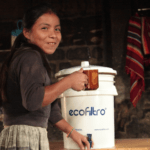Serving Smallholder Farmers in the Digital Age: Why it Requires Treating Data Like an Asset
Satellites. The internet of things. Big data. Blockchain. These concepts, among others, can elicit images of a futuristic world for the agricultural sector—and one that is still years away. Then again, maybe not. GSMA estimates that by 2020 almost three-quarters of the world’s population will subscribe to mobile services and that the next wave of mobile connections will mostly come from rural areas, where smallholder farmers produce the majority of food, yet often live in poverty. The rise of mobile phones in rural regions has the potential to change the face of smallholder farming and help lift remote communities out of poverty.
The spread of mobile technology combined with remote-sensing data, distributed computing and storage capabilities are opening up new opportunities to integrate smallholder farm households into the broader agri-food system. This change begins with one basic activity: compiling farmer profiles. How farmer profiles are compiled, stored, analyzed and utilized using advanced digital technologies can drive whether, and how quickly, agricultural development is able to end poverty and hunger among rural populations.
So what are farmer profiles? Governments and their partners have collected data on and about farmers for decades. More recently, agribusinesses, mobile network operators, financial service providers and other companies have done the same. Typically, their data collection activities share a common goal: to understand farmer needs for products, information services, market linkages and finance. As a result, farmers often spend hours repeatedly answering analogous questions from service providers seeking to understand their customers. Yet the information gathered is often insufficient to fully inform the comprehensive solutions and partnerships needed to transform smallholder farming into viable, sustainable businesses.
As technology use increases and improves in rural areas, the paradigm for how smallholder farmers are profiled and defined is shifting. To help describe this shift, Grameen Foundation, supported by USAID’s Digital Development for Feed the Future (D2FTF) and FHI 360, conducted a landscape assessment that:
- Documents the types of service providers that collect farmer profile data, how data is collected, analyzed and used to support smallholders with products and services, and how this data is shared and managed
- Highlights innovative models of smallholder farmer data management and sharing in order to inspire new thinking among actors in this space, and
- Outlines key considerations when assessing existing efforts, or investing in new efforts, to develop and leverage farmer profile data.
Findings from the landscape assessment will be shared during a webinar at 10 a.m. EDT, April 9.
The assessment reveals innovations in the use of digital technologies all along the smallholder farmer data value chain–from how farmers are identified to how data is shared and managed. For example, satellites, remote sensors and drones can be used to capture data on the farm—and on the plants and soil conditions, without the need for intensive field agent data collection processes. Social media data, like Facebook data, can be mined to develop chatbots that draw on cognitive analytics to immediately respond to farmer questions about livestock disease outbreaks, providing timely support to farmers at low cost. Open data sharing platforms, which draw on thousands of studies and research databases, can facilitate the creation of new data, allowing typically siloed data to be combined for new insights. Mobile phone usage data can be analyzed to predict a user’s occupation, and therefore what type of farming information might be most useful to him or her.
When smallholder farmer data is digital—and is combined with farm data (such as data on the plants grown or soil conditions) and other big data sources or complementary data sources, such as national identity registries—we can minimize the amount of time requested of farmers for their data. We can also build farmer profiles that are dynamic; that integrate comprehensive data on the farm and farmer; that can be leveraged for timely support to the farmer; and that the farmer her/himself could own and control.
Data-driven agriculture is already creating a new economy, one where data itself is currency. Data is being monetized and sold—whether to provide crucial information to financial services providers to develop appropriate agricultural finance products, or to support input suppliers trying to serve their target markets. Who controls that data, and how it is used, will determine the success of service providers and farmers alike. Data is no longer just a resource, but an asset.
In summary, the data and the technology (hardware and software) exist to solve many constraints that farmers face. But these resources are still fragmented, and not all service providers—let alone farmers—have equal opportunities to access them. Data science—some might say “Big Data analytics”—promises to bring fragmented data, resources and service providers together to support the farmer ecosystem.
The farmer profile landscape assessment itself will be published later this year. It represents a starting point for further discussion on how we can develop and leverage smallholder farmer profile data. Until then, join us for the webinar on April 9 to be part of the first conversation.
The upcoming webinar and paper, titled “Data-driven Agriculture: The Future of Smallholder Farmer Data Management and Use” was supported by Digital Development for Feed the Future (D2FTF). D2FTF is a collaboration between USAID’s Global Development Lab and Bureau for Food Security and is focused on integrating a suite of coordinated digital tools and technologies into Feed the Future activities to accelerate agriculture-led economic growth and improved nutrition. Feed the Future is America’s initiative to combat global hunger and poverty.
Note: This post is one of NextBillion’s 12 most influential posts of 2018.
Bobbi Gray is research director at Grameen Foundation.
Ellen Galdava manages an FHI 360 ICT for agriculture program under the Digital Development Feed the Future (D2FTF) initiative.
Photo courtesy of Grameen Foundation.
- Categories
- Agriculture



